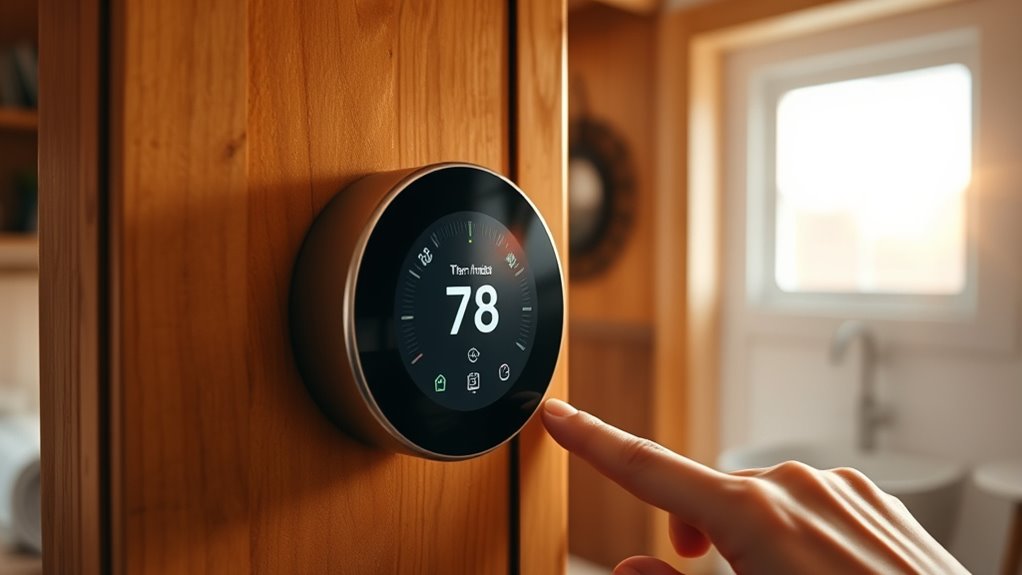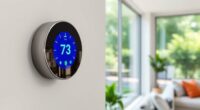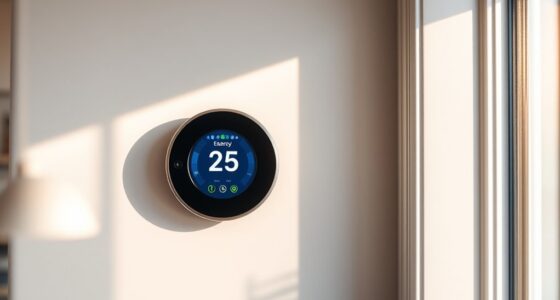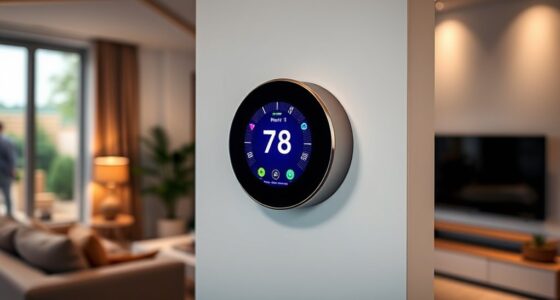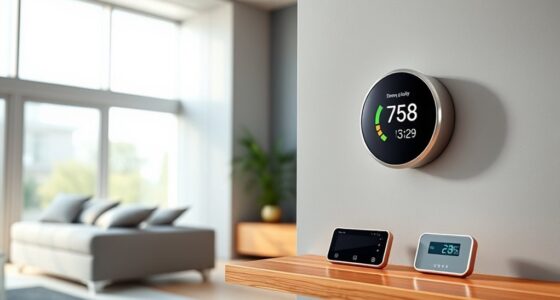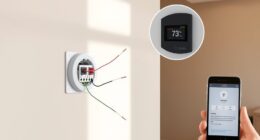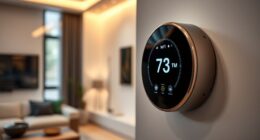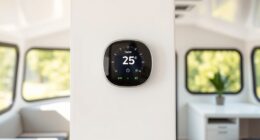When buying a smart thermostat for your tiny house, focus on features like adaptive learning, zoning, and remote control to maximize efficiency and comfort. Choose a model compatible with your mobile device and easy to install, ideally with clear wiring instructions. Install it in a central, draft-free spot at eye level for accurate readings. Exploring the latest options will help you make the best choice for your small space. Keep going to discover more tips for smart thermostat success.
Key Takeaways
- Choose thermostats with adaptive learning and zoning features for personalized comfort in limited space.
- Ensure compatibility with your mobile devices and remote control options for convenience.
- Prioritize energy efficiency features to reduce heating and cooling costs in small homes.
- Confirm proper placement guidelines to achieve accurate readings and optimal performance.
- Consider professional installation if unsure about wiring or compatibility with your existing system.
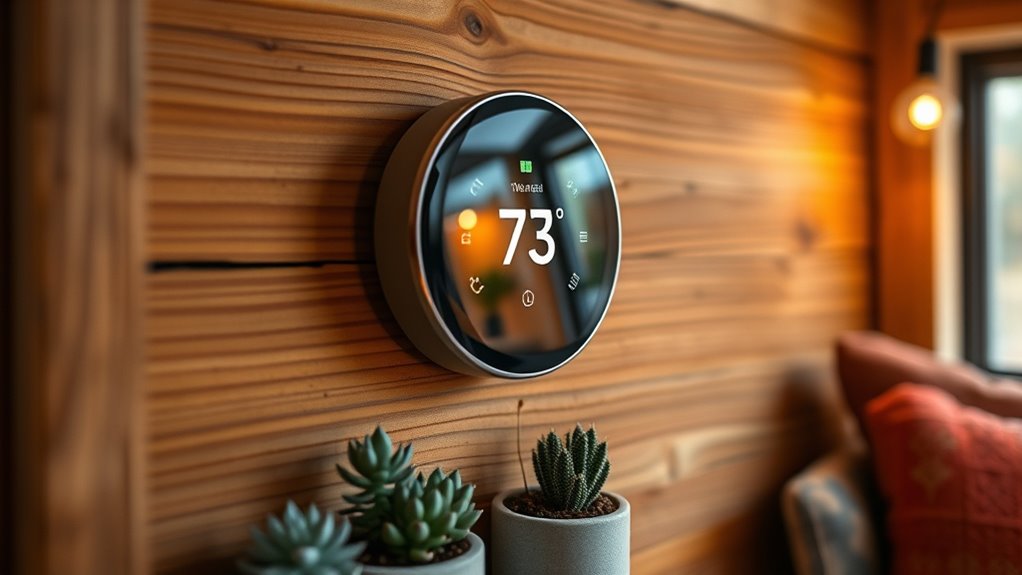
If you’re living in a tiny house, choosing the right smart thermostat can substantially improve comfort and energy efficiency. Tiny homes often have limited space and are more sensitive to temperature fluctuations, so a smart thermostat becomes an essential tool for maintaining a cozy environment while keeping energy costs down. When selecting a thermostat, focus on energy efficiency features like adaptive learning, zoning capabilities, and remote control options. These features allow you to optimize heating and cooling, ensuring you don’t waste energy heating an empty space or cooling an unoccupied room. With a well-chosen thermostat, you can set your preferred temperature and let it automatically adjust based on your habits, saving you money over time.
Installation tips are also vital when integrating a smart thermostat into your tiny house. Many models are designed for straightforward installation, often requiring just a few basic tools and some familiarity with your existing wiring. First, turn off your power supply to avoid any electrical mishaps. Then, remove your old thermostat and carefully connect the new smart device following the manufacturer’s instructions. It’s important to match the wires correctly—most smart thermostats have color-coded terminals and wiring diagrams to guide you. If you’re unsure, consulting a professional electrician can prevent potential issues and guarantee your setup is safe and reliable.
Ensure safe installation by turning off power, matching wires correctly, and consulting professionals if needed.
Placement of the thermostat also plays a significant role in maximizing energy efficiency. Install it in a central location away from direct sunlight, drafts, or heat sources like lamps and appliances. This ensures the thermostat accurately reads your home’s temperature, allowing your system to operate efficiently. For tiny houses, where space is tight, mounting the device at eye level on an interior wall is usually ideal. Keep in mind that some smart thermostats come with additional sensors that can be placed in different rooms, helping you create zones that enhance both comfort and energy savings. Additionally, understanding the Ford Tuning principles can be useful when considering performance upgrades for vehicles, which could be relevant if your tiny house is on a motorhome or RV platform.
Finally, take advantage of the smart features your thermostat offers. Use the companion app to monitor energy usage and adjust settings remotely. Many models also include scheduling options, so you can set specific temperatures for different times of the day, further boosting energy efficiency. By carefully choosing a smart thermostat with these features and following proper installation tips, you’ll enjoy a more comfortable tiny home environment while reducing your energy consumption. It’s an investment that pays off in comfort, savings, and peace of mind.
Frequently Asked Questions
Can Smart Thermostats Control Multiple Zones in Tiny Houses?
Yes, smart thermostats can control multiple zones in tiny houses. Look for models with multi-zone control and compatible zoning systems, which allow you to independently manage different areas. This setup helps you save energy and stay comfortable by customizing temperatures for each zone. Installing a zoning system with your smart thermostat makes it easier to optimize heating and cooling, especially in small spaces with varied usage areas.
Are There Budget-Friendly Options Suitable for Tiny House Heating Needs?
Yes, there are budget-friendly options perfect for tiny house heating needs. You can find smart thermostats that are affordable yet effective in managing your space’s temperature. Look for models with basic features, easy installation, and energy efficiency to save money long-term. These options allow you to control your tiny house’s climate without overspending, making them ideal for small spaces where cost and functionality are both important.
How Do Smart Thermostats Integrate With Off-Grid Solar Systems?
Smart thermostats often integrate well with off-grid solar systems by offering solar compatibility and battery integration. You can connect them to your solar panels and batteries, allowing efficient energy use and control over your tiny house’s heating. They automatically adjust settings based on sunlight and battery levels, helping you conserve power while maintaining comfort. Just verify your thermostat is compatible with your specific solar setup for seamless operation.
Is Professional Installation Necessary for Smart Thermostats in Tiny Homes?
You don’t always need a professional to install your smart thermostat; DIY installation is often straightforward, especially if you follow the manufacturer’s instructions. Just make certain compatibility considerations are met with your tiny house’s wiring and system setup. While some models might require expert help, many are designed for easy installation, saving you time and money. If you’re comfortable with basic electrical work, you can confidently install your thermostat yourself.
Can Smart Thermostats Operate Reliably During Power Outages?
Smart thermostats can operate reliably during power outages if you add a battery backup, ensuring they stay powered. However, their internet dependency means they might lose remote control or advanced features when Wi-Fi is down. To maximize reliability, consider a model with a built-in backup power source and minimize reliance on internet connectivity. This way, your tiny house stays comfortable, even during unexpected outages.
Conclusion
Imagine stepping into your tiny house on a chilly evening, the warmth greeting you like a cozy hug. With a smart thermostat, you control that perfect temperature effortlessly, saving energy and money while creating a haven tailored just for you. It’s more than technology—it’s peace of mind wrapped in comfort. Make the smart choice today, and turn your tiny house into a warm, inviting retreat you’ll love coming home to every day.
